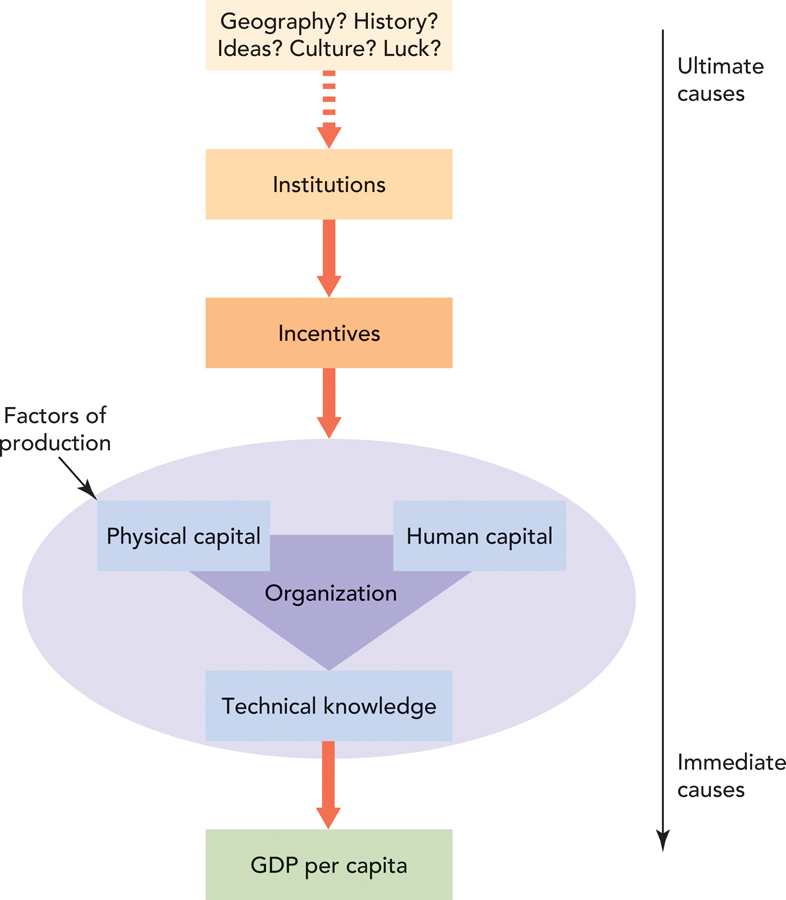Understanding the Wealth of Nations
Let’s begin with Figure 7.5 on the next page, a guide to the major factors behind the wealth of nations. At the bottom of the figure is what we would like to explain, GDP per capita. As we move up the figure, we see some of the causes of the wealth of nations, beginning with the immediate or most direct causes and moving toward the ultimate or indirect causes.
FIGURE 7.5

The Factors of Production
The most immediate cause of the wealth of nations is this: Countries with a high GDP per capita have a lot of physical and human capital per worker and that capital is organized using the best technological knowledge to be highly productive. Physical capital, human capital, and technological knowledge are called factors of production. Let’s take a look at each factor of production.
Physical capital is the stock of tools including machines, structures, and equipment.
By physical capital (or just “capital”), economists mean tools in the broadest sense: pencils, desks, computers, hammers, shovels, tractors, cell phones, factories, roads, and bridges. More and better tools make workers more productive.
Farming is a good illustration of the role of capital. In much of the world, farmers are laborers pure and simple: They dig, seed, cut, and harvest using hard labor and a few simple tools like hoes and plows (often pulled by oxen). In the United States, farmers use a lot more capital—tractors, trucks, combines, and harvesters.
It’s not just farmers who use a lot of capital. The typical worker in the United States works with more than $100,000 worth of capital. A typical worker in India works with less than one-tenth as much capital.
It’s also not just physical capital that makes U.S. farmers productive. Farmers in the United States riding a tractor use a GPS receiver to triangulate their exact location using signals from a series of satellites orbiting the earth some 16,500 miles high. The tractor’s location is combined with data from other satellites and land-based sensors to precisely adjust the amount of seed, fertilizer, and water to be applied to the land. The fertilizer has been carefully designed, and the seeds almost certainly have been genetically engineered.
Human capital is the productive knowledge and skills that workers acquire through education, training, and experience.
The high-tech nature of farming in the United States draws our attention to the importance of human capital and technological knowledge. Human capital is tools in the mind, or the stuff in people’s heads that makes them productive. Human capital is not something we are born with—it is produced by an investment of time and other resources in education, training, and experience. Farmers in the United States, for example, have more human capital than farmers in most of the world, and it’s this human capital that enables them to take advantage of tools like GPS receivers. The same is true in the larger economy—the typical person in the United States, for example, has about 12 years of schooling, while in Pakistan the typical person has less than 5 years of schooling.
The greater quantities of physical and human capital per worker used in U.S. farming make U.S. farmers more productive. U.S. farmers produce more than three times as much corn per acre than do farmers in Pakistan, for example.
The third factor of production is technological knowledge. This factor includes, for instance, the genetics, chemistry, and physics that form the basis of the techniques used in U.S. agriculture. (Did you know that the clocks on GPS satellites must be adjusted to account for the effects of Einstein’s theory of relativity?)

Technological knowledge is knowledge about how the world works that is used to produce goods and services.
Technological knowledge and human capital are related but different. Human capital is the knowledge and skills that a farmer needs to understand and to make productive use of technology. Technological knowledge is knowledge about how the world works—the kind of knowledge that makes technology possible. We increase human capital with education. We increase technological knowledge with research and development. Technological knowledge is potentially boundless. We can learn more and more about how the world works even if human capital remains relatively constant.
CHECK YOURSELF
Question 7.4
 Which country has more physical capital per worker: the United States or China? China or Nigeria?
Which country has more physical capital per worker: the United States or China? China or Nigeria?
Question 7.5
 What are the three primary factors of production?
What are the three primary factors of production?
Improved technological knowledge has made U.S. farmers more productive over time. U.S. farms today produce more than two and a half times as much output as they did in 1950 and they do so using less land! More physical and human capital has helped to drive this increase in output, but better technological knowledge has been the primary factor.1
The final factor, a factor often taken for granted, is organization. Human capital, physical capital, and technological knowledge must be organized to produce valuable goods and services. Who does this organizing and why? To answer this question, we turn to the issue of incentives and institutions.